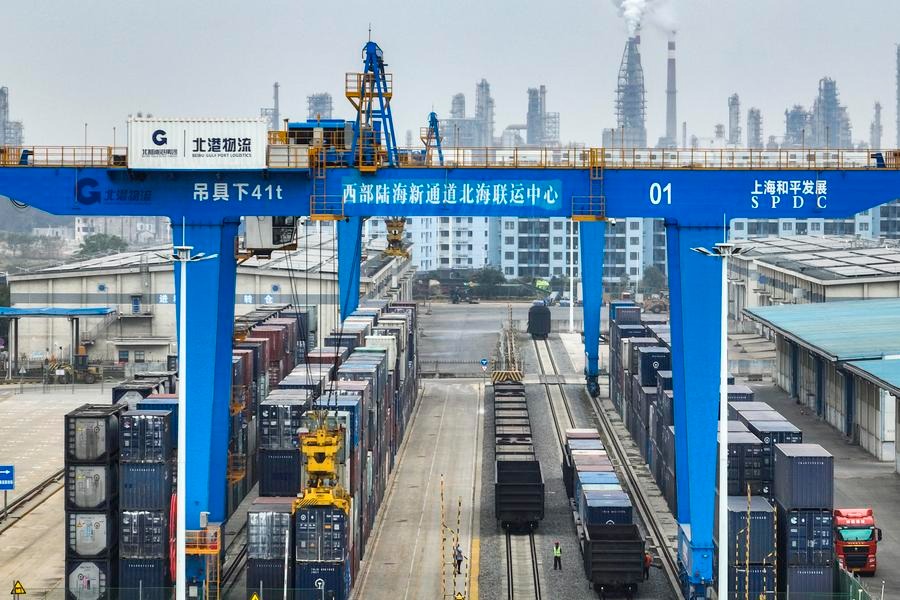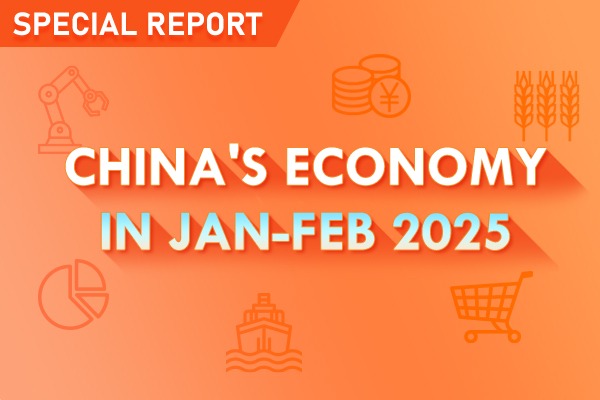Upping public sector investment a remedy for consumption slump

Since the fourth quarter of last year, the overall perceptions of China's macroeconomy have changed. Seen from both data and market sentiment perspectives, overall market confidence and expectations have improved. However, concerns persist.
While there are some bright spots in the real economy, it has yet to fully emerge from the dilemma of insufficient demand. The economy is currently in a "climbing" phase. This ongoing phase is crucial — if policies can intensify and provide a push, it can fully escape the trap of insufficient demand, leading to smoother development in the future. But if the policy response is weak, the climb will be very difficult, and the economy may struggle to break through or take longer to recover from insufficient demand.
The Central Economic Work Conference and the Government Work Report from the two sessions have already outlined the proper direction. The next step is to further optimize policies in line with the latest macroeconomic changes in order to more rapidly escape the predicament of insufficient demand.
In a market economy, individual rational decisions can, in some cases, lead to irrational overall outcomes. For example, in an environment of insufficient demand, a decline in household income leads to reduced consumption, falling corporate profits lead to reduced investment and a drop in government fiscal revenue leads to reduced spending. Taken individually, these are rational choices, but the outcome is that each economic agent ends up in a worse off situation — this is a typical market failure phenomenon.
Why emphasize this? Because market failure makes it difficult to rely on the market's own forces to self-correct and regain traction. Relying entirely on market-driven recovery inputs is costly and even unsustainable. We must depend on external forces to push the economy out of the trap of insufficient demand.
Insufficient demand is not merely a static issue but can lead to a negative spiral involving income, spending and credit, which deepens the economic predicament. It requires a force that exceeds market expectations — an external and stronger power — to break out of this cycle. So, where does this force come from?
Currently, we are placing great emphasis on stimulating consumption and have introduced a series of policies to promote it. These policies are helping to boost demand. However, at the same time, we cannot overlook the role of investment, especially the guiding role of public investment with its distinct exogenous nature. In fact, without the support of public investment, it would be difficult to truly escape the dilemma of insufficient demand.
First, consumption and investment are not in a "zero-sum" relationship. Historical data show that consumption and investment are actually highly positively correlated. In other words, more investment leads to more consumption, while less investment leads to less consumption.
Both are positively correlated with GDP growth. The logic behind this is simple — more investment means more expenditure, which in turn creates more income, and increased income naturally supports higher consumption.
Second, investment is a "fast variable", while consumption is a "slow variable". Consumption involves the decision of millions of households, with each person consuming daily. But consumption adjustments are slow because they depend on long-term income changes. Consumption is an endogenous variable, making it difficult to rapidly boost buying appetites overnight.
On the other hand, investment, particularly public investment, is driven by the decisions of a few entities (such as the government), and it can be significantly adjusted in the short term. Investment is a "fast variable" and has a strong exogenous nature. In other words, the government can rapidly increase public investment, while consumption growth takes longer to materialize.
Third, relying solely on consumption will be insufficient to fill the demand gap. We have conducted some calculations, and to overcome insufficient demand and restore the CPI to around 2 percent for moderate inflation, GDP needs to fill a demand gap of 5 trillion yuan ($687 billion) to 6 trillion yuan.
If we rely solely on consumption to fill this gap, consumption growth would need to exceed 15 percent. Achieving such high consumption growth in the current environment would require a significant rise in household incomes, which is clearly unrealistic. Solely depending on consumption is far from sufficient. We must drive demand recovery through both "consumption +investment", particularly through public investment.
When discussing investment, some concerns arise. For example, investment already accounts for a high share of the economy, while consumption remains relatively low. Why should we continue to increase investment?
Additionally, some worry that China has already made significant investments in infrastructure, including railways, highways and airports, and manufacturing capacity is sufficient. Will continued investment lead to overcapacity and resource wastage? These concerns are valid but need clarification.
First, looking back at past experience, the periods of the most rapid consumption growth also coincided with the periods of the fastest investment growth, during which times consumption rates decreased. Only when the economy overcomes insufficient demand and the environment stabilizes will consumption rates organically rise.
From the perspective of manufacturing investment, China's share of manufacturing investment is indeed high compared to developed countries. In infrastructure areas such as railways, highways, airports and power grids, the investment scale in recent years has also been large. However, if we focus on public service investments, we find that their share is significantly low. In countries like the United States, Germany, South Korea and France, the share of public service investment in total investment usually exceeds 17 percent while China's share is less than 5 percent. Regarding private service investments, China's share is also far below that of developed countries.
In terms of funding sources and debt sustainability for public investment, the core goal of public investment is to serve the public interest, so it should not be evaluated solely based on commercial returns or market profitability.
If a project does not generate profits, that does not justify withholding investment. Many infrastructure and public service projects' core value lies in improving social welfare rather than directly generating profits. Therefore, they should not be assessed with the same standards used for market investments.
Second, public investment needs to rely on government credit and adopt low-cost, long-term financing methods. In the past, many urban development projects relied on local governments' hidden debt financing, which is clearly unsustainable and risks leaving large fiscal burdens, high-interest costs and mismatched debt maturity issues. For future public investments, more emphasis should be placed on using low-cost, long-term government financing channels to reduce fiscal pressure.
Furthermore, financing methods should be tailored to the specific nature of the project. If a project benefits a broad population, it should be led by the central government and financed through measures such as issuing national bonds. If the project mainly benefits a specific locality, the local government should bear the corresponding investment responsibility.
Additionally, if a project has certain commercial returns, such as some urban renewal projects, financing can be sourced through public-private partnerships, fiscal subsidies and support from policy-driven financial institutions, optimizing the funding structure and improving investment efficiency.
Lastly, we must address a core issue — the sustainability of government debt. Many worry that large-scale government borrowing for investment might worsen fiscal burdens. In fact, from the perspective of fiscal sustainability, government borrowing in the current economic environment would not introduce serious debt risks.
On the contrary, it could enhance fiscal stability. When the government increases investment, it can directly drive economic growth, increase tax revenue, boost land transfer income and support asset prices. As the economy recovers, various government revenues will increase, strengthening the overall capacity to service debt.
In the long term, the sustainability of government debt mainly depends on the comparison between debt growth and GDP growth. If the government's real interest rate is lower than the GDP growth rate, debt levels will decrease.
The writer is deputy director of the Chinese Academy of Social Sciences' Institute of World Economics and Politics.
The views do not necessarily reflect those of China Daily.




































